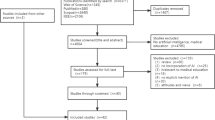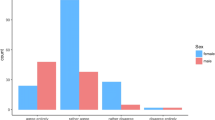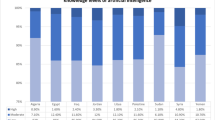Abstract
Objective
Currently, there is a worldwide shift toward competency-based medical education. This necessitates the use of automated skills assessment methods during self-guided interventions training. Making assessment methods that are transparent and configurable will allow assessment to be interpreted into instructional feedback. The purpose of this work is to develop and validate skills assessment methods in ultrasound-guided interventions that are transparent and configurable.
Methods
We implemented a method based upon decision trees and a method based upon fuzzy inference systems for technical skills assessment. Subsequently, we validated these methods for their ability to predict scores of operators on a 25-point global rating scale in ultrasound-guided needle insertions and their ability to provide useful feedback for training.
Results
Decision tree and fuzzy rule-based assessment performed comparably to state-of-the-art assessment methods. They produced median errors (on a 25-point scale) of 1.7 and 1.8 for in-plane insertions and 1.5 and 3.0 for out-of-plane insertions, respectively. In addition, these methods provided feedback that was useful for trainee learning. Decision tree assessment produced feedback with median usefulness 7 out of 7; fuzzy rule-based assessment produced feedback with median usefulness 6 out of 7.
Conclusion
Transparent and configurable assessment methods are comparable to the state of the art and, in addition, can provide useful feedback. This demonstrates their value in self-guided interventions training curricula.






Similar content being viewed by others
References
Harden RM, Stevenson M, Downie WW, Wilson GM (1975) Assessment of clinical competence using objective structured examination. Br Med J 1(5955):447–451
Winckel CP, Reznick RK, Frcsc M, Cohen R (1994) Reliability and construct validity of a structured technical skills assessment form. Am J Surg 167:423–427
Gofton WT, Dudek NL, Wood TJ, Balaa F, Hamstra SJ (2012) The Ottawa surgical competency operating room evaluation (O-SCORE): a tool to assess surgical competence. Acad Med 87(10):1401–1407
Martin JA, Regehr G, Reznick R, Macrae H, Murnaghan J, Hutchison C, Brown M (1997) Objective structured assessment of technical skill (OSATS) for surgical residents. Br J Surg 84(2):273–278
Reiley CE, Lin HC, Yuh DD, Hager GD (2011) Review of methods for objective surgical skill evaluation. Surg Endosc 25(2):356–366
Vedula SS, Ishii M, Hager GD (2017) Objective assessment of surgical technical skill and competency in the operating room. Annu Rev Biomed Eng 19(1):301–325
Fraser SA, Klassen DR, Feldman LS, Ghitulescu GA, Stanbridge D, Fried GM (2003) Evaluating laparoscopic skills, setting the pass/fail score for the MISTELS system. Surg Endosc Other Interv Tech 17(6):964–967
Stylopoulos N, Cotin S, Maithel SKK, Ottensmeye M, Jackson PGG, Bardsley RSS, Neumann PFF, Rattner DWW, Dawson SLL, Ottensmeyer M, Jackson PGG, Bardsley RSS, Neumann PFF, Rattner DWW, Dawson SLL (2004) Computer-enhanced laparoscopic training system (CELTS): bridging the gap. Surg Endosc 18(5):782–789
Chmarra MK, Klein S, de Winter JCF, Jansen F-WW, Dankelman J (2010) Objective classification of residents based on their psychomotor laparoscopic skills. Surg Endosc Other Interv Tech 24(5):1031–1039
Allen B, Nistor V, Dutson E, Carman G, Lewis C, Faloutsos P (2010) Support vector machines improve the accuracy of evaluation for the performance of laparoscopic training tasks. Surg Endosc 24(1):170–178
Oropesa I, Sánchez-González P, Chmarra MK, Lamata P, Pérez-Rodríguez R, Jansen FW, Dankelman J, Gómez EJ (2014) Supervised classification of psychomotor competence in minimally invasive surgery based on instruments motion analysis. Surg Endosc Other Interv Tech 28(2):657–670
Ahmidi N, Poddar P, Jones JD, Vedula SS, Ishii L, Hager GD, Ishii M (2015) Automated objective surgical skill assessment in the operating room from unstructured tool motion in septoplasty. Int J Comput Assist Radiol Surg 10(6):981–991
Fard MJ, Ameri S, Darin Ellis R, Chinnam RB, Pandya AK, Klein MD (2017) Automated robot-assisted surgical skill evaluation: Predictive analytics approach. Int J Med Robot Comput Assist Surg 14(1):e1850
Kramer BD, Losey DP, O’Malley MK, O’Malley MK (2016) SOM and LVQ classification of endovascular surgeons using motion-based metrics. In: Merényi E, Mendenhall MJ, O’Driscoll P (eds) Advances in self-organizing maps and learning vector quantization: proceedings of the 11th international workshop WSOM 2016, Houston, Texas, USA, January 6–8, 2016, vol. 428. Springer, Cham, pp 227–237
Uemura M, Tomikawa M, Miao T, Souzaki R, Ieiri S, Akahoshi T, Lefor AK, Hashizume M (2018) Feasibility of an AI-based measure of the hand motions of expert and novice surgeons. Comput Math Methods Med. https://doi.org/10.1155/2018/9873273
Hajshirmohammadi I, Payandeh S (2007) Fuzzy set theory for performance evaluation in a surgical simulator. Presence Teleoper Virtual Environ 16(6):603–622
Riojas M, Feng C, Hamilton A, Rozenblit J (2011) Knowledge elicitation for performance assessment in a computerized surgical training system. Appl Soft Comput J 11(4):3697–3708
Huang J, Payandeh S, Doris P, Hajshirmohammadi I (2005) Fuzzy classification: towards evaluating performance on a surgical simulator. Stud Health Technol Inform 111:194–200
Kotsiantis SB (2007) Supervised machine learning: a review of classification techniques. Informatica 31:249–268
Chiticariu L, Li Y, Reiss F (2015) Transparent machine learning for information extraction: state-of-the-art and the future. In: Conference on empirical methods in natural language processing, pp 4–6
Rosen J, Brown JD, Chang L, Barreca M, Sinanan M, Hannaford B (2002) The BlueDRAGON—a system for measuring the kinematics and dynamics of minimally invasive surgical tools in-vivo. IEEE Int Conf Robot Autom 2:1876–1881
Forestier G, Lalys F, Riffaud L, Trelhu B, Jannin P (2012) Classification of surgical processes using dynamic time warping. J Biomed Inform 45(2):255–264
Doughty H, Damen D, Mayol-Cuevas W (2018) Who’s better? Who’s best? pairwise deep ranking for skill determination. In: 2018 IEEE/CVF conference on computer vision and pattern recognition, pp 6057–6066. https://doi.org/10.1109/CVPR.2018.00634
Kowalewski TM, Comstock B, Sweet R, Schaffhausen C, Menhadji A, Averch T, Box G, Brand T, Ferrandino M, Kaouk J, Knudsen B, Landman J, Lee B, Schwartz BF, McDougall E, Lendvay TS (2016) Crowd-sourced assessment of technical skills for validation of basic laparoscopic urologic skills tasks. J Urol 195(6):1859–1865
Holden MS, Lia H, Xia S, Keri Z, Ungi T, Fichtinger G (2018) Configurable overall skill assessment in ultrasound-guided needle insertion. In: 16th annual imaging network Ontario symposium (ImNO)
Frank E, Trigg L, Holmes G, Witten IH (2000) Technical note: Naive Bayes for regression. Mach Learn 41(1):5–25
Al Iqbal MR, Rahman S, Nabil SI, Chowdhury IUA (2012) Knowledge based decision tree construction with feature importance domain knowledge. In: 2012 7th international conference on electrical and computer engineering, pp 659–662
Silverman BW (1986) Density estimation for statistics and data analysis, no. 1951
Xia S, Keri Z, Holden MS, Hisey R, Lia H, Ungi T, Mitchell CH, Fichtinger G (2018) A learning curve analysis of ultrasound-guided in-plane and out-of-plane vascular access training with Perk Tutor. In: Medical imaging 2018: image-guided procedures, robotic interventions, and modeling, vol 10576, p 66
Lasso A, Heffter T, Rankin A, Pinter C, Ungi T, Fichtinger G (2014) PLUS: open-source toolkit for ultrasound-guided intervention systems. IEEE Trans Biomed Eng 61(10):2527–2537
Ungi T, Sargent D, Moult E, Lasso A, Pinter C, McGraw RC, Fichtinger G (2012) Perk tutor: an open-source training platform for ultrasound-guided needle insertions. IEEE Trans Biomed Eng 59(12):3475–3481
Domuracki K, Wong A, Olivieri L, Grierson LEM (2015) The impacts of observing flawed and flawless demonstrations on clinical skill learning. Med Educ 49(2):186–192
Ma IWY, Zalunardo N, Pachev G, Beran T, Brown M, Hatala R, McLaughlin K (2012) Comparing the use of global rating scale with checklists for the assessment of central venous catheterization skills using simulation. Adv Health Sci Educ 17(4):457–470
Zia A, Sharma Y, Bettadapura V, Sarin EL, Clements MA, Essa I (2015) Automated assessment of surgical skills using frequency analysis. In: Medical image computing and computer-assisted interventions—MICCAI 2015, Pt I, vol 9349, pp 430–438
Zia A, Sharma Y, Bettadapura V, Sarin EL, Essa I (2018) Video and accelerometer-based motion analysis for automated surgical skills assessment. Int J Comput Assist Radiol Surg 13(3):443–455
Stumpf S, Rajaram V, Li L, Burnett M, Dietterich T, Sullivan E, Drummond R, Herlocker J (2007) Toward harnessing user feedback for machine learning. In: Proceedings of the 12th international conference on Intelligent user interfaces—IUI’07, p 82
Talbot J, Lee B, Kapoor A, Tan DS (2009) EnsembleMatrix: interactive visualization to support machine learning with multiple classifiers. Learning. https://doi.org/10.1145/1518701.1518895
Hendricks LA, Akata Z, Rohrbach M, Donahue J, Schiele B, Darrell T (2016) Generating visual explanations. In: Lecture notes in computer science (including subseries lecture notes in artificial intelligence and lecture notes in bioinformatics), vol 9908. LNCS, pp 3–19
Muir BM (1987) Trust between humans and machines, and the design of decision aids. Int J Man Mach Stud 27(5–6):527–539
McGraw R, Chaplin T, McKaigney C, Rang L, Jaeger M, Redfearn D, Davison C, Ungi T, Holden M, Yeo C, Keri Z, Fichtinger G (2016) Development and evaluation of a simulation-based curriculum for ultrasound-guided central venous catheterization. In: CJEM, pp 1–9
Datta V, Mackay S, Mandalia M, Darzi A (2001) The use of electromagnetic motion tracking analysis to objectively measure open surgical skill in the laboratory-based model. J Am Coll Surg 193(5):479–485
Holden MS, Keri Z, Ungi T, Fichtinger G (2017) Overall proficiency assessment in point-of-care ultrasound interventions: the stopwatch is not enough. In: Cardoso MJ, Arbel T, Tavares JMRS, Aylward S, Li S, Boctor E, Fichtinger G, Cleary K, Freeman B, Kohli L, Shipley Kane D, Oetgen M, Pujol S (eds) Imaging for patient-customized simulations and systems for point-of-care ultrasound: international workshops, BIVPCS 2017 and POCUS 2017, held in conjunction with MICCAI 2017, Québec City, QC, Canada, September 14, 2017. Springer International Publishing, Cham, pp 146–153
Lia H, Keri Z, Holden MS, Harish V, Mitchell CH, Ungi T, Fichtinger G (2017) Training with Perk Tutor improves ultrasound-guided in-plane needle insertion skill. In: SPIE medical imaging, 2017, p 101350T
Acknowledgements
Matthew S. Holden is supported by the Link Foundation Fellowship in Modeling, Simulation, and Training. Gabor Fichtinger is supported by a Canada Research Chair in Computer-Integrated Surgery.
Author information
Authors and Affiliations
Corresponding author
Ethics declarations
Conflict of interest
All authors declare that they have no conflict of interest.
Ethical approval
All procedures in this study involving human participants were performed in accordance with the ethical standards of the institution and were approved by the research ethics board at Queen’s University. This study does not contain any procedures involving animals.
Informed consent
All participation was voluntary, and written informed consent was obtained from all participants.
Additional information
Publisher’s Note
Springer Nature remains neutral with regard to jurisdictional claims in published maps and institutional affiliations.
Rights and permissions
About this article
Cite this article
Holden, M.S., Xia, S., Lia, H. et al. Machine learning methods for automated technical skills assessment with instructional feedback in ultrasound-guided interventions. Int J CARS 14, 1993–2003 (2019). https://doi.org/10.1007/s11548-019-01977-3
Received:
Accepted:
Published:
Issue Date:
DOI: https://doi.org/10.1007/s11548-019-01977-3




